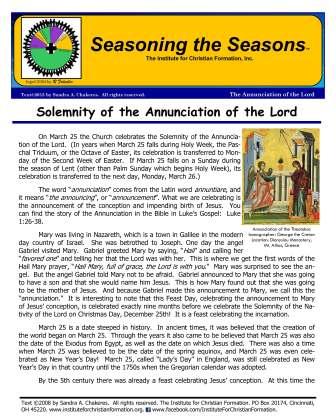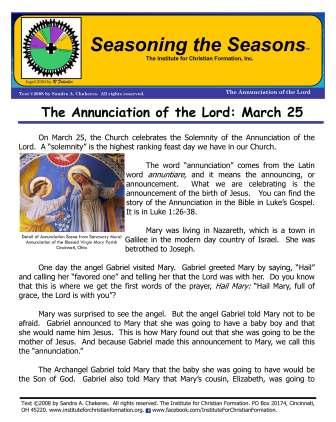The Institute for Christian Formation
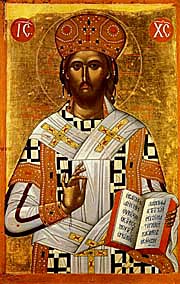
Solemnity of the Annunciation of the Lord: March 25
On March 25 the Church celebrates the Solemnity of the Annunciation of the Lord. (In years when March 25 falls during Holy Week, the Paschal Triduum, or the Octave of Easter, its celebration is transferred to Monday of the Second Week of Easter. If March 25 falls on a Sunday during the season of Lent (other than Palm Sunday which begins Holy Week), its celebration is transferred to the next day, Monday, March 26.)
The word “annunciation” comes from the Latin word "annuntiare", and it means “the announcing”, or "announcement”. What we are celebrating is the announcement of the conception and impending birth of Jesus. You can find the story of the Annunciation in the Bible in Luke’s Gospel: Luke 1:26-38.
Mary was living in Nazareth, which is a town in Galilee in the modern day country of Israel. She was betrothed to Joseph. One day the angel Gabriel visited Mary. Gabriel greeted Mary by saying, “Hail” and calling her “favored one” and telling her that the Lord was with her. This is where we get the first words of the Hail Mary prayer, “Hail Mary, full of grace, the Lord is with you.” Mary was surprised to see the angel. But the angel Gabriel told Mary not to be afraid. Gabriel announced to Mary that she was going to have a son and that she would name him Jesus. This is how Mary found out that she was going to be the mother of Jesus. And because Gabriel made this announcement to Mary, we call this the “annunciation.” It is interesting to note that this Feast Day, celebrating the announcement to Mary of Jesus’ conception, is celebrated exactly nine months before we celebrate the Solemnity of the Nativity of the Lord on Christmas Day, December 25th! It is a feast celebrating the incarnation.
March 25 is a date steeped in history. In ancient times, it was believed that the creation of the world began on March 25. Through the years it also began to be believed that March 25 was also the date of the Exodus from Egypt, as well as the date on which Jesus died. There was also a time when March 25 was believed to be the date of the spring equinox, and March 25 was even celebrated as New Year’s Day! March 25, called “Lady’s Day” in England, was still celebrated as New Year’s Day in that country until the 1750s when the Gregorian calendar was adopted. While this might sound odd to us, think about the naming of our months, for example September (for the number seven), October (for the number eight), November (for the number nine), and December (for the number ten). Counting backwards, that would make March the first, rather than the third month. Interesting…
By the 5th century there was already a feast celebrating Jesus’ conception. At this time the East celebrated this feast on December 26, while the West celebrated it the Sunday before Christmas. But by the middle of the 6th century in the East and from the 7th century in the West, this feast was celebrated on March 25.
Today in our Catholic Church we celebrate this feast day as the Solemnity of the Annunciation of the Lord. A solemnity is the highest ranking feast day in our Catholic Church Calendar. This is a feast of the Lord, as we are celebrating the Lord’s conception.
You can download our ICF bulletins on the Solemnity of the Annunciation of the Lord below. There is one for adults and another for children.
While four gospels made it into our canon of Scripture, there were many other “apocryphal” writings which were not included in our Bible, yet had an impact on our art, liturgy, and even our Church Calendar. One of these writings is the Protoevangelium of James. Paragraphs 10 and 11 of this document from the time of the early Church deal with the Annunciation and what Mary was doing before, during, and after the angel’s visit to her. According to this document, Mary had been chosen to spin the scarlet and true purple thread to make a veil for the temple of the Lord. She was spinning the scarlet thread when she went out to get a pitcher of water and the angel appeared to her. This detail of Mary spinning the scarlet thread for the temple veil has made its way into many of the traditional Eastern icons of the Annunciation, as you can see in this image.
A garden is often somehow represented in Annunciation images. This might be a depiction of Mary, herself, in a garden at the time of the angel’s visitation, or a reference to Adam and Eve being expelled from the Garden of Eden, or perhaps aspects of both. In this 15th century Annunciation work by Fra Angelico, you see the
As already noted, the opening words of the prayer, the Hail Mary, come from the Annunciation Gospel, Luke 1:28. The Annunciation is also part of our prayer and devotional life in other ways. The First Joyful Mystery of the Rosary is the Annunciation. And it is also the Annunciation which gives us the Angelus prayer. It used to be that people could actually tell the time of day by hearing the ringing of the church’s angelus bells at 6:00 a.m., 12:00 noon, and 6:00 p.m. Even today many people pause at these times to recall Christ’s incarnation by praying the Angelus:
THE ANGELUS
V: The angel of the Lord declared unto Mary,

R: and she conceived of the Holy Spirit.
Hail, Mary…..
V: Behold, the handmaid of the Lord;
R: let it be done to me according to thy word.
Hail, Mary…..
V: And the Word was made flesh
R: and dwelt among us.
Hail, Mary…..
V: Pray for us, O Holy Mother of God,
R: that we may be made worthy of the promises of Christ.
Let us pray.
Lord, fill our hearts with your grace,
and as you revealed to us by an angel
the coming of your Son as man,
so lead us through his suffering and death
to the glory of his resurrection.
We ask this through Christ our Lord.
Amen.
In 1974, Pope Paul VI wrote an Apostolic Exhortation, Marialis Cultus (For the Right Ordering and Development of Devotion to the Blessed Virgin Mary). In paragraph 41 of this document, Pope Paul addresses the Angelus, exhorting its continued “traditional recitation wherever and whenever possible.”
Both in the East and the West, the Annunciation has been a popular subject for artists. Throughout the years there have been some common themes and symbols, as well as some differing themes and symbols, which have made their way into traditional Annunciation art. We will look at a few of these here.
Mary is also often pictured as being at prayer at the moment of the Archangel Gabriel’s annunciation to her. In the Fra Angelico painting, you see the open prayer book in Mary’s lap. In the detail from the 20th century mural at Annunciation Parish, Cincinnati, Ohio, you see Mary rising from a prie dieu (prayer desk/kneeler) which has prayer books on it, and in the stained glass window scene, Mary is kneeling in prayer. (It is interesting how time and culture make their way into our artwork, as prayer books and wooden kneelers would not have been items Mary would have had available to her.)
Follow us on Facebook to keep up to date with our news and newest resources!
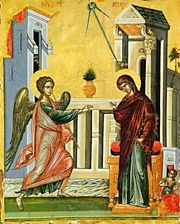
Annunciation of the Theotokos
Iconographer: George the Cretan
Location: Dionysiou Monastery,
Mt. Athos, Greece
Click on the image above to download our ICF bulletin, "Solemnity of the Annunciation of the Lord" (adult/teen version).
Click on the image above to download our ICF bulletin, "The Annunciation of the Lord" (children's version) .
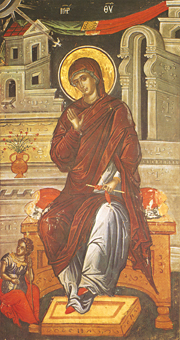
Virgin Theotokos
(Detail of Annunciation)
Iconographer:
Theophanes the Cretan, 1545
Location:
Stavronikita Monastery, Greece,
Chapel of St Nicholas
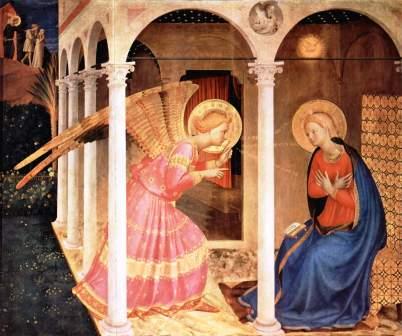
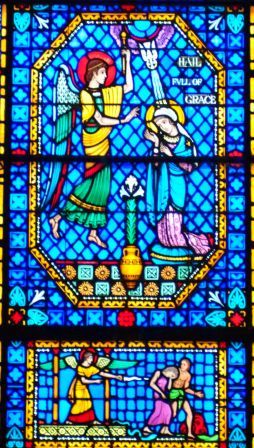
The Annunciation
Fra Angelico, 1433-1434
Museo Diocesano, Cortona
Annunciation Stained Glass Window
Annunciation of the Blessed Virgin Mary Parish, Cincinnati, Ohio
flowering garden in the left part of the image, and in the top left you see a darker, smaller image of Adam and Eve being cast out of paradise. In this 20th century stained glass art from Annunciation Parish in Cincinnati, Ohio, you see the scene of Adam and Eve being cast out of Paradise directly below the scene of the Annunciation. The theological insight behind these depictions is that Mary’s “yes” – her obedience to God – reverses the disobedience of Adam and Eve at the “Fall.” Whereas Adam’s sin closed the gates of Paradise, Mary’s obedience paved the way for the birth of Christ, who opened the gates of Paradise through his saving death and resurrection.
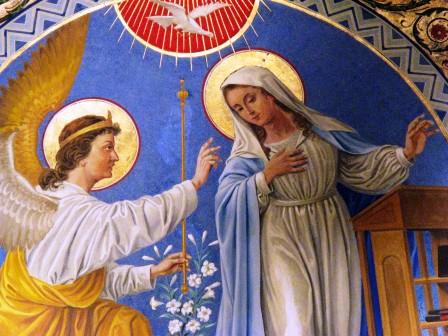
The Annunciation
Detail from Mural by Gerhard Lamers, 1953
Annunciationof the Blessed Virgin Mary Parish
Cincinnati, Ohio
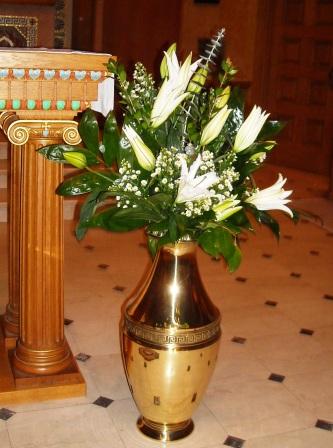
You also see that the lily is prominent in both the stained glass and mural detail. The lily, symbolic of Mary’s purity, is a very common symbol of the Annunciation.
As you celebrate the Solemnity of the Annunciation of the Lord this year, make a special dinner, set a nice table, and include a vase of lilies as a centerpiece. In parts of Scandinavia, waffles with lots of whipped cream on top are a traditional food for the Annunciation. In fact, in Sweden March 25 is Vdffeldagen, or “Waffle Day.” In England, there was a tradition of making a seed cake for the Annunciation.
And in Greece, where March 25 is celebrated both as the Annunciation and Greek Independence Day, a favorite food is fried cod with a very garlicky side dish. And if none of these foods appeal to you, you can always have angel food cake for dessert in honor of the Archangel Gabriel’s announcement to Mary!
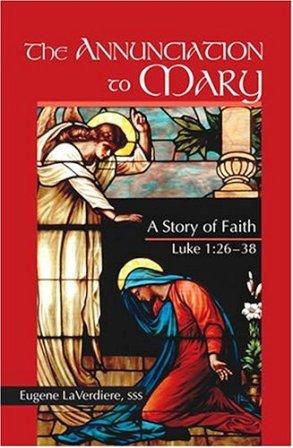
If you would like to explore the Annunciation in some more depth, a recommended book for adults is “The Annunciation to Mary: A Story of Faith, Luke 1:26-38” by Rev. Eugene LaVerdiere, S.S.S.
There is a lovely Basque carol, “Gabriel’s Message,” which reflects on the Annunciation and the Incarnation. You can download the score for this hymn here. We will conclude our reflection on the Annunciation with the video below, featuring Terry McDade and the McDades performing this carol.
